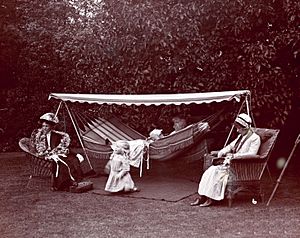Gertrude Wilkinson facts for kids

Gertrude Jessie Heward Wilkinson (1851 – 19 September 1929) was a brave British woman. She was a Suffragette, which means she fought for women's right to vote. She was a member of the Women's Social and Political Union (WSPU). Because of her actions, she was sent to Winson Green Prison. While there, she went on a hunger strike and was force-fed. For her courage, she received the WSPU's Hunger Strike Medal. In 1913, she became the Literature Secretary for the Women's Freedom League (WFL). Sometimes, she used the name Jessie Howard.
Early Life and Family
Gertrude Jessie Heward Bell was born in 1851 in Ickenham, Middlesex. Her parents were Jessie and Benjamin Bell. When she was 18, she married William John Wilkinson, a solicitor, on June 14, 1870. They were married at St John's church in Hampstead. Gertrude and William had seven children together. Their children were Eleanor, William, John, Ethel, Martin, Geoffrey, and Leonard.
Fighting for Women's Rights

Gertrude Wilkinson was very active in the fight for women's right to vote. This movement was called women's suffrage. During her work, she sometimes used the name Jessie Howard.
In 1909, she was seen campaigning in Whitstable. She was with Rose Emma Lamartine Yates and another woman named Miss Barry. Rose Yates had a holiday home nearby, and Gertrude would often stay close by. Even when on holiday, these suffragettes continued to campaign for women's voting rights.
In 1912, Gertrude was sent to prison for her actions. While in prison, she went on a hunger strike. This meant she refused to eat to protest her imprisonment and the government's refusal to grant women the vote. Because of this, she was force-fed. This was a painful process where food was forced into her body. For her bravery during this time, she was given the WSPU's Hunger Strike Medal.
To keep their spirits up in prison, the women found ways to entertain themselves. Some, like Emmeline Pethick-Lawrence, told stories. Emmeline Pankhurst, a leader of the WSPU, would share memories of the early days of the movement. On June 10, 1912, three grandmothers who were imprisoned – Gertrude Wilkinson, Janet Boyd, and Mary Ann Aldham – sang together. Another time, some of the women performed a scene from a play called The Merchant of Venice.
Gertrude Wilkinson was a member of the Sheffield branch of the WSPU. In 1913, she became the Literature Secretary for the Women's Freedom League (WFL). This group also worked for women's rights.
The photograph shows Gertrude Wilkinson in the middle. On the left is Edith Marian Begbie, and on the right is Florence Macfarlane. The child kneeling in front is Paul Lamartine Yates, who was three years old. He was the son of Rose Emma Lamartine Yates. Rose Yates was an important organizer for the Wimbledon branch of the WSPU. The picture was taken around 1912 at her home, Dorset Hall, in Merton Park.
Gertrude Wilkinson lived at 29 Oakley Square in Camden Town. She passed away in September 1929 at 6 Osnaburgh Terrace in Euston.
See also
 In Spanish: Gertrude Wilkinson para niños
In Spanish: Gertrude Wilkinson para niños

